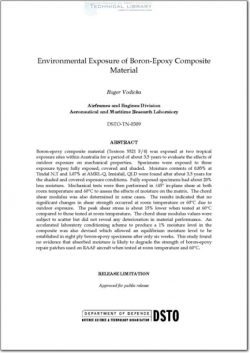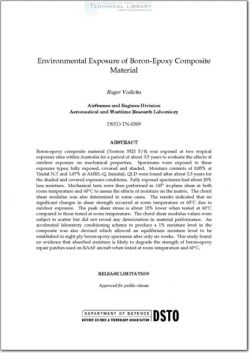DSTO-TN-0309

- Version
- 177 Downloads
- 272.09 KB File Size
- 1 File Count
- August 10, 2016 Create Date
- August 10, 2016 Last Updated
Environmental Exposure of Boron Epoxy Composite Material

Polymer matrix composite materials are becoming increasingly prevalent in modern
military aircraft, either as original structure (graphite—epoxy wing—skins on the F / A—18)
or as modifications or repairs.
The Bonded Repair Technology pioneered by DSTO typically uses repair patches made
from boron—epoxy material. These patches have proven to be very successful and some
are still in service after 25 years. No study has been undertaken to determine if the
strength of such patches is degraded by representative levels of absorbed moisture.
It is well known that the properties of composite materials are degraded when exposed
to hot/ wet conditions. A typical composite material will begin to absorb moisture
from the air soon after manufacture to a level of about 1% by weight after long-term
service. Combined with elevated temperature experienced during flight this hot/ wet
conditioning of the material can degrade matrix properties by up to 25% for supersonic
aircraft and 15% for subsonic. An understanding of hot/ wet performance is vital in
determining the operational envelope.
This paper details the results of experimental work to determine the effects of tropical
outdoor exposure on boron—epoxy composite material (Textron 5521 F / 4).
The exposure of boron—epoxy composite specimens showed that the samples absorb
0.85% moisture at Tindal NT and 1.07% at AMRL—Q, Innisfail, QLD after 3.5 years.
The weather patterns at Tindal are highly influenced by the tropical wet and dry
seasons which see significant drying of the composite during a dry season cycle.
AMRL—Q tends to produce a more consistent hot and humid environment all year
round.
Mechanical testing showed no significant contribution of the moisture in reducing the
i45° in—plane shear stress when tested at both room temperature and 60°C. The peak
shear stress does however decrease by about 15% when compared to specimens tested
at room temperature.
This work has successfully determined the moisture content levels produced in boron—
epoxy material during tropical exposure. Such information is vital in evaluating the
effects of moisture on adhesively bonded composite repairs in the laboratory. The
durability of the boron—epoxy material, as proved by mechanical tests, shows that this
material is likely to perform well in tropical environments over the long term and serve
the RAAF well as a repair material.
| File | Action |
|---|---|
| DSTO-TN-0309 Environmental Exposure of Boron Epoxy Composite Material.pdf | Download |

Comment On This Post